Human body connections resist daily load, so they become sensitive to different types of destructive factors. Among the diseases of the joints, arthrosis is often found, and affects both large and small joints. Knee joint arthritis is degenerative-district damage to the knee joint, in which its motor activity is concerned. In the absence of proper treatment, the disease can lead to disability.
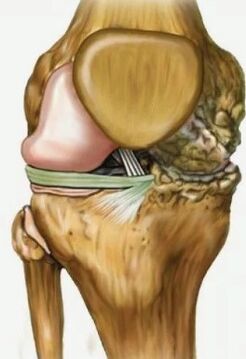
Since the disease provokes characteristic deformities in the joints, it is called the deforming arthrosis of the knee joint, which rightly describes the typical characteristic of the pathology. The disease is chronic and is more often diagnosed in women, with excess weight and venous pathology of the lower extremities, but there may be other causes. Due to age -related changes, people also arise in the elderly.
New arthrosis can be provoked by damage. As a result of degenerative-district changes, the cartilage is softened, delayed and covered with cracks of different depths. Then, he ceases to fulfill his function.
Reason
Various causes lead to the appearance of distorting arthrosis of the knee. A traumatic factor is a common cause of occurrence. Post -traumatic arthritis can develop due to taking displacement or fracture in the specified area, as well as meniscus damage. Typically, knee joint gonarthrosis appears in young people who are actively involved in sports, or in those people whose work is associated with increased mobility, lifting and weight transfer.
Few people know that such damage can be a consequence of treatment, when the damage itself has already been cured, but during long -term immobilization of the limbs there were blood circulation disorders in the area. Because of this, gonarthrosis appeared.
Increased physical exercise in the knee is one of the main factors in the onset of the disease. Most often affect athletes who have constant active knee loads. At a young age, arthritis may not appear, the rapid changes usually begin after the end of physical activity.
There is also a risk of disease in those people who, even in adulthood, do not reduce the load on the joints. In such athletes, the risk of fractures and displacements increases, microtraumas appear. Therefore, after forty years, doctors recommend that athletes reduce the loads, switch to exercise work. Running and meetings are best excluded, as it is these kinds of activity that above all load the knee joint. Most often, a limb is affected and one -sided gonartrosis or one -sided gonartrosis occurs.
Meniscus removal becomes an essential factor for the development of knee joint arthrosis. If for some reason the meniscus was removed, then this in 90 percent of cases leads to the appearance of arthrosis-so-called baking knee, during which the articular joints suffer more friction than usual.
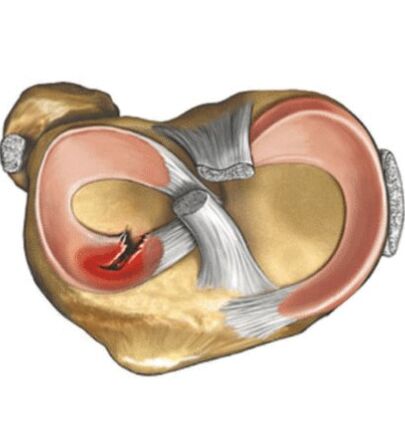
This is the case with meniscus arthroscopy - a tear - which can be a stimulus for arthrosis of the knee joint
The problem of overweight is also important for people with arthritis. Excessive body weight creates unnecessary pressure on the joints. As a result, the cartilage itself is damaged, but the meniscus. And with an overweight combination, acute arthritis threatens varicose veins of the lower extremities.
Poor ligamentous apparatus in some patients is an innate feature, and sometimes ligaments are affected by other diseases. In one way or in another way, weak ligaments provoke increased mobility in the joint, which is why the articular surfaces are significantly corrosive. The consequences of weak ligaments may not feel for a long time until patients experience the symptoms of true arthrosis.
Common pathologies also lead to the development of the disease. Most often, arthritis becomes the culprit of the appearance of arthrosis - inflammation of the articular joints. With arthritis, typical signs are observed - a deterioration in the composition of synovial fluid, pathological changes in cartilage, swelling, soft tissue redness. Even after osteoarthritis, chronic processes lead to the appearance of arthrosis.
Violations of metabolic processes often lead to pathology of the muscular system. Bones and joints do not take nutrients and minerals, so necessary for tissue strength. With their lack of bone surfaces and cartilage undergoing destructive processes, therefore, even with a slight load, primary arthrosis appears.
Symptoms
Knee joint arthrosis is manifested by a complex of characteristics that are difficult to not notice. There are no signs only in the first degree of development of pathology, but the second and third degree gives clear symptoms of knee joint arthrosis:
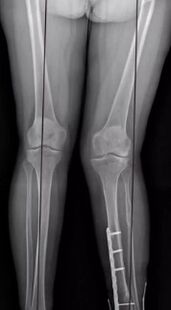
The degree of development
The arthrosis of the knee joint develops in its three -degree development.
With 1st degree arthrosis, painful pain and occurs only with active physical exercise in the knee joint. Already in the first extent, the fluid in the cavity can accumulate, which in the second and third is already a cyst. With progress, the pain occurs in the process of movement, but quickly passes. From the outside, the deformation of the knee joint is invisible, so the diagnosis of knee joint arthrosis can be difficult.
Arthrosis pain even appears when the external signs of the disease are not visible
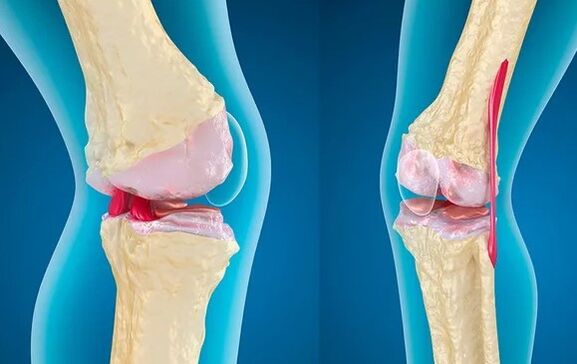
With a second -degree disease, damage to the cartilage tissue is more important. If you get an X-ray, then the bone growth phase is already visible in it. With any movement, sudden acute pain appears in the knee, but, returning to a suitable position, the knee no longer hurts. In the second phase of Doa, you can hear a typical arthritis crisis. When progressing, problems with stretching and bending the knee have worsened. The deformation becomes visible in appearance.
The osteoarthrosis of the third -degree knee joint is characterized by a considerable thinning of the cartilage. Gradually, the cartilage is soaked so much that the bone is exposed to some areas. The X -Ray photo shows a significant amount of osteophytes - bone growth, salts that appeared in the joint cavity. From the outside, the changes are clearly visible, and the patient deals with persistent pain. It is easy to make a diagnosis-there is a sufficient visual examination and a retigenic check is performed.
With the advancement of this scale, arthritis can lead to a complete loss of functionality. At any degree of development of pathology, the knee joint osteoarthritis can merge.
Treatment
Tory
A group of most active anti -arthrosis medicines is non -steroidal anti -inflammatory drugs. These are mainly inhibitors of cyclooxygenase-2, they can perfectly relieve inflammation, swelling and contribute to rapid recovery as possible. These medicines have significant restrictions, so they cannot be used without a doctor's recommendation. For example, they are able to worsen a stomach ulcer, heart disease and urinary tract pathology. Non -inflammatory anti -inflammatory drugs are prohibited during pregnancy.
The second set of funds is chondroprotectors that improve cartilage characteristics. They are used for arthritis to restore the exact structure of the cartilage, because in the solution process it loses very important ingredients - chondroit and glucosamine. Therefore, almost all chondroprotectors have both of these substances, but some medicines are a component. With the help of these medicines, you can help the patient in the first and second stages of developing the disease, but not in the third, when irreversible changes occurred.
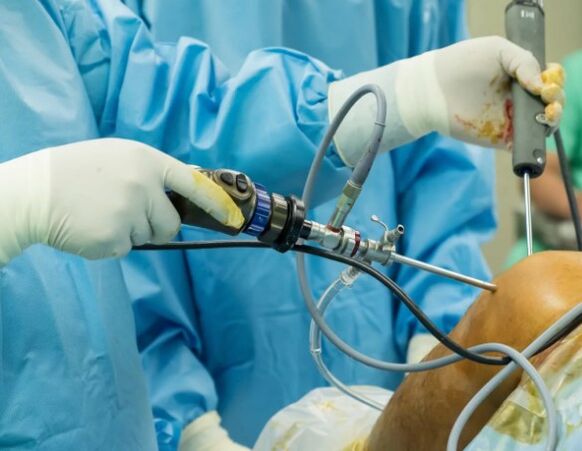
During conservative therapy, the doctor will give nutrition recommendations. If a patient or patient has overweight, it is necessary to adhere to a diet to normalize weight. How to strengthen your steady weight - the doctor will also show. It is also not recommended to eat a lot of salt, but it is best to fill the diet with calcium, vitamins and minerals. Jelly, jelly, will be useful.
OPErATiONAl
The most common type of surgical intervention for arthrosis is arthroscopy, but other interventions are performed. The treatment of knee joint arthrosis is usually performed in the second and third degree, when conservative therapy no longer helps.
If necessary, minimal invasive interference, for example, when collecting a fluid in the knee joint, it is possible to do with a puncture. In the cavity of the knee joint, a puncture is made and the excess fluid is pumped. This method can be diagnosed with the disease, so it is applied for treatment at the same time. The fluid is taken at the initial stage in a minimal amount, but this already significantly improves the well -being of patients. Then, after studying the biomaterial, removed another part, and corticosteroids are inserted into the joint cavity.
Endoprostetics is sometimes the only way out to patients with third -degree arthrosis
Arthroscopy is more common. Through a small incision, some tools are inserted into the skin, which allow you to do a joint examination and the necessary manipulations in it. With the help of arthroscopy, you can remove the fabric particles separated by the cartilage, but there is always a risk that secondary gonartrosis will appear.
With severe damage, there is a need to perform a periosenantial osteotomy. This is a greater effect on the joint, as a result of which it is slightly fed and installed at the right angle. After surgery, rehabilitation is longer, but the effect lasts longer.
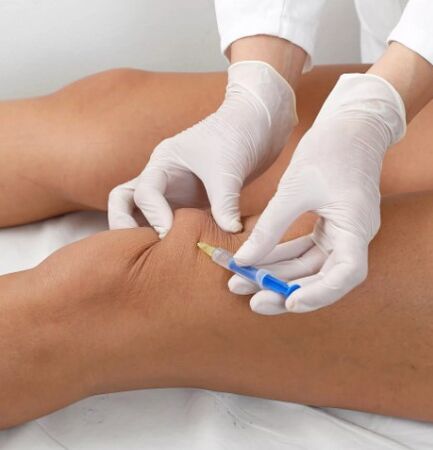
Significant destruction of articular elements leads to complete immobilization of the limbs. The connection does not fulfill its function, which means that it must be replaced and you have to do the operation. The endoprostetics of the knee joint is an expensive operation, but it makes it possible to return movement to the patient into the limbs. Different knee prostheses - plastic, ceramic or metal are installed. These are sustainable constructions that allow you to forget the problem for several decades.
physiotherapy
Physiotherapy methods can only be used when acute periods have passed and the patient is healing.
Among the techniques are actively used:
They use not only ozonotherapy and kinesiotherapy, but also physiotherapy exercises. Good results are given by copyright methods to eliminate knee arthrosis - exercises in Bubnovsky, Evdokimenko, Dikul. During the exercises and after them, we need to wear a special knee pillow - an orthosis, to strengthen the right or left knee joint.



















